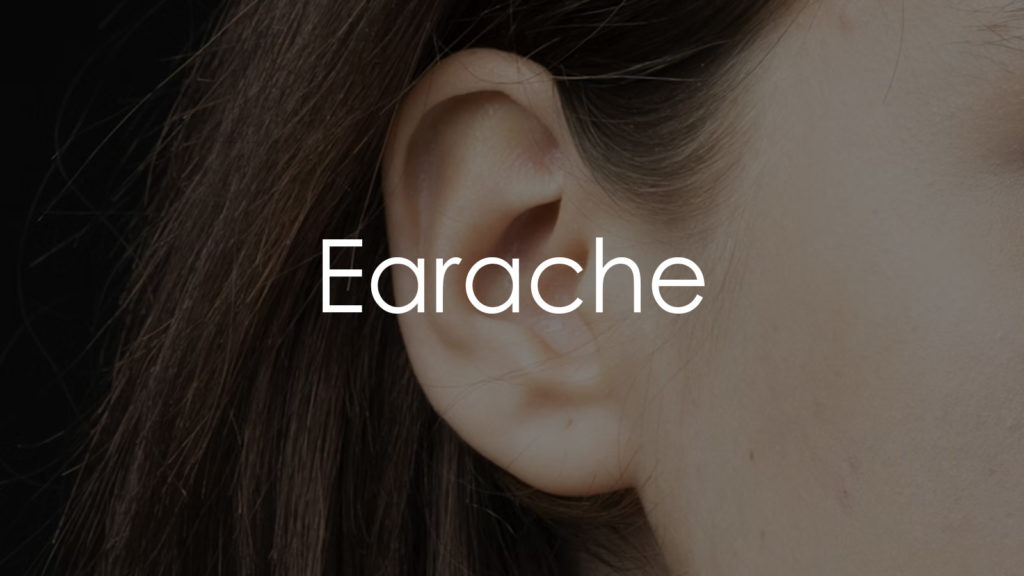Earache, or otalgia, is a common condition that can affect people of all ages, causing discomfort or pain in one or both ears. The pain can be sharp, dull, or burning and may be constant or come and go. Earaches can originate from problems within the ear itself or be referred pain from sources outside the ear. Understanding the various causes of ear pain is crucial for determining the appropriate course of action and treatment.

Causes and Possible Diseases
Ear pain can be attributed to several factors and underlying conditions:
- Ear Infections (Otitis Media and Externa)
- Infections in the middle ear (otitis media) or the outer ear canal (otitis externa, also known as swimmer’s ear) are common causes of ear pain, often accompanied by redness, swelling, and fluid discharge.
- Eustachian Tube Dysfunction
- The Eustachian tube connects the middle ear to the throat. Dysfunction can lead to pressure changes and discomfort, particularly during altitude changes.
- Foreign Objects
- Small objects or excessive earwax buildup can block the ear canal, causing pain.
- Temporomandibular Joint (TMJ) Disorders
- Problems with the jaw joint and surrounding muscles can cause referred pain to the ear.
- Sinus Infections
- Sinusitis can cause pressure and pain that radiates to the ears.
- Dental Problems
- Tooth infections, impacted wisdom teeth, and gum disease can cause referred pain to the ear.
- Throat Infections
- Throat infections, including tonsillitis or pharyngitis, can lead to ear pain due to shared nerve pathways.
When to See a Doctor?
Seek medical attention for an earache if:
- Severe or Persistent Pain
- If the ear pain is severe or does not improve within a few days.
- Signs of Infection
- Accompanied by symptoms such as fever, fluid drainage, hearing loss, dizziness, swelling around the ear, or severe sore throat.
- Difficulty Hearing
- Sudden hearing loss or significant difficulty hearing can indicate a more serious issue.
- Young Children
- Infants and young children with ear pain should see a doctor, especially if they are too young to verbalize their discomfort or if they show signs of being unusually irritable.
- Presence of a Foreign Object
- If you suspect something is stuck in the ear.
- Following an Injury
- If ear pain occurs after a head injury or sudden changes in air pressure (such as after flying or scuba diving).
Prompt evaluation and treatment can prevent complications, alleviate pain, and address the underlying cause of the earache. Treatments may vary from simple measures like warm compresses and pain relief medications to more specific interventions such as antibiotics for infections, earwax removal, or treatment for TMJ disorders. Early intervention is key to a quick recovery and preventing potential hearing damage or other complications.
Diagnostics
To determine the cause of an earache, healthcare providers may employ a variety of diagnostic tools and methods:
- Otoscopic Examination: A visual inspection of the outer ear, ear canal, and eardrum using an otoscope to identify signs of infection, inflammation, blockage, or damage.
- Tympanometry: A test that uses sound and air pressure to assess the eardrum’s movement and the middle ear’s function, helping to detect fluid, infection, or eustachian tube dysfunction.
- Hearing Tests (Audiometry): Conducted if the patient experiences hearing loss, to evaluate the type and extent of hearing impairment.
- Laboratory Tests: If a secondary infection is suspected, such as in cases of sore throat or sinusitis contributing to ear pain, throat swabs or blood tests may be performed.
- Imaging: In cases where structural abnormalities or serious infections are suspected, imaging studies like CT or MRI scans may be recommended.
Treatment
The treatment for an earache depends on its underlying cause:
- For Ear Infections
- Bacterial Infections: Prescribed antibiotics, either oral or as ear drops.
- Viral Infections: Typically managed with pain relief and supportive care, as antibiotics are not effective against viruses.
- Eustachian Tube Dysfunction
- Decongestants, nasal corticosteroids, or autoinflation exercises to relieve pressure.
- Foreign Object or Earwax Blockage
- Professional removal by a healthcare provider to avoid damage to the ear canal or eardrum.
- TMJ Disorders
- Pain relievers, muscle relaxants, or physical therapy. In some cases, dental interventions may be necessary.
- For Referred Pain from Dental or Sinus Issues
- Treating the underlying condition, which may involve antibiotics, dental procedures, or sinus care.
- Pain Management
- Over-the-counter pain relievers such as ibuprofen or acetaminophen can help alleviate discomfort.
Conclusion
Earaches are a common symptom with a wide range of potential causes, from minor conditions like earwax buildup to more serious infections. Accurate diagnosis is crucial for effective treatment and preventing complications. If you experience persistent, severe, or accompanied by additional symptoms ear pain, it’s important to seek medical attention to address the underlying issue. With appropriate care, most earaches can be successfully treated, restoring comfort and safeguarding ear health. Remember, early intervention is key to managing ear pain effectively and ensuring a swift return to normal activities.